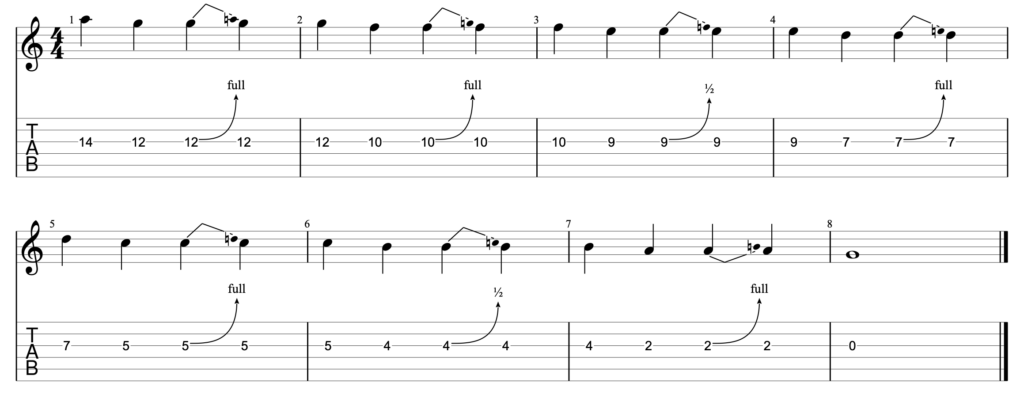This article is part of the series “Level Up! – 42 guitar solos for a better sex life”
Table of Contents
Bendings
We guitar players are envied for this technique!
Pulling the strings (bending) creates a sound that is very characteristic of good blues, rock and metal solos.
What types of bends are there? Here is a brief overview:
Semitone and whole-tone bendings
This type of bend is the basis of all other bends.
Instead of playing the note directly, you start on a lower note and pull the string until the desired note is reached.
I practice bends by always striking the target tone first, then the starting tone, and then I pull the string.
This means that I can still understand how the tone should sound.
For example, we want to play the note C. To do this, we start with the B and pull the string until the C sounds.
This is then a semitone bending.
To avoid boredom, I recommend the following exercise:
As a basis we use the A minor scale again and work our way down the fingerboard.
We do this because the bends are easier in the middle of the fingerboard than near the saddle.
Can you also bend more than one whole tone?
Of course it works! Check it out in Hotel California, there is a transition from B to D in the first bar.
That is three semitones or a minor third. (see intervals)
In the solo of “Another brick in the wall” David Gilmour bends a major third, i.e. four semitones from C to E.
Awesome!
But here it comes: in the same solo, just a few bars later he adds a semitone and goes from C to F.
Absolutely perverted. Five semitones! A whole fourth!
When doing this, you should put on your safety goggles in case the string breaks. I do not take any guarantee!
Release Bends
If we have mastered this basis, we can also dare to tackle the release bends.
To do this, a normal bend is performed, but without striking the string beforehand.
Only when we have pulled up the string do we strike it and then release the tension again.
This creates a very elegant effect.
Unison Bendings
Unison bendings are difficult and easy at the same time: difficult because we have to hit the same note,
that resonates on the string below. Easy, because thanks to the beat, we can hear very well if we have not yet reached the note.
Oblique Bends
With the oblique bends, it is not the target tone that sounds, but a minor third, for example. Very powerful tool!
Double Stops
Double stops are the end boss because we are playing two strings at the same time:
GuitarPro
Download GuitarPro file
Don’t own a copy of GuitarPro yet?
I’d be very happy if you buy it via one of my affiliate link:
Guitar pro Version 8 (Amazon Affiliate)
Guitar Pro Version 8 (Thomann Affiliate)






